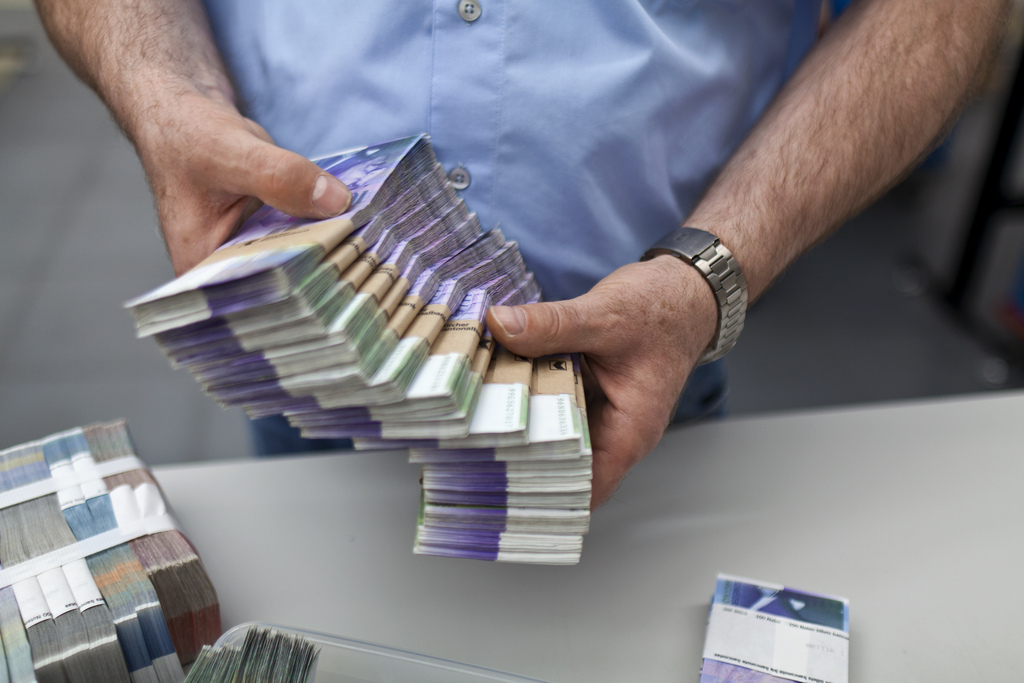Printer admits CHF1.8m theft of 1,000-franc notes

The theft of 1,800 thousand-franc notes from a high security Swiss printing plant has sparked an investigation after some of the high denomination cash was found in London.
Three people, two in the British capital – one of whom was a Swiss resident – and another in Zurich, were arrested after the theft was discovered last autumn. The Swiss resident was sentenced in London to a prison term and spent seven months in jail, while the Zurich suspect spent two-and-a-half months in detention.
The trio, plus an unknown number of accomplices, are still being investigated by the Swiss Attorney General’s office as the Swiss National Bank (SNB) tries to track down the remainder of the missing unfinished notes.
The alarm was raised on October 5, 2012, by Britain’s Serious Organised Crime Agency when two men tried to change 37 notes at a London bureau de change. Full details of the fraud had been withheld from the public until Tuesday to avoid compromising investigations.
It is unclear exactly how many of the notes are still in circulation, but 17 have been recovered in the past two weeks, according to the attorney general’s office.
The printing company Orell Füssli, that has been commissioned to produce Swiss bank notes since the 1970s, has admitted that it is fully responsible and will foot the bill for the security breach.
The violet thousand-franc bill depicting the face of 19th century art historian Jacob Burckhardt is the banknote with the second-highest denomination in the world, right behind Singapore’s S$10,000 (CHF7,355), and ahead of the €500 bill.
Almost one in ten of all Swiss bank notes in current circulation is the CHF1,000.
The total value of all CHF1,000 ($1,070) notes in circulation was more than CHF35 billion in 2012. Their share in the CHF55 billion total of all Swiss banknotes rose to a record 60 per cent last year from 50 per cent a year earlier.
Swiss banknote circulation is the second highest in the world behind Japan and more than double that in the United States or the euro zone.
Spotting a fraud
The firm issued a profit warning on September 9, alerting shareholders to a potential CHF8 million charge relating to the mishap. This would likely result in a financial loss for the group in 2013, it said.
“Orell Füssli has painstakingly reviewed its security measures in detail, arranged for a security audit to be conducted by an independent agency and taken action in organisational and personnel terms to tighten its security precautions,” the company said in a separate statement issued on Tuesday.
The SNB called on people to hand in suspicious bank notes, for which they would be reimbursed. While the notes in question might look real at first glance, they should be relatively easy to spot on close inspection because they were taken from the printers before they could be finished.
Among the details to look out for are the lack of a serial number or evidence that such a number had been printed on after they were stolen.
Switzerland is one of the few countries to print such large denomination bank notes. Despite fears that the 1,000-franc note could help criminals smuggle large quantities of cash over borders more easily, the SNB has no plans to discontinue them.
Speaking to swissinfo.ch in July, the SNB said that the popularity of cash trades in Switzerland “is no indication for illegal usage”. The CHF1,000 note is mainly used by “used car dealers and cattle traders”, the central bank added.
But some other countries have stopped printing their own high denomination notes or accepting those in other currencies after suspecting they were being used for criminal purposes.

In compliance with the JTI standards
More: SWI swissinfo.ch certified by the Journalism Trust Initiative









You can find an overview of ongoing debates with our journalists here . Please join us!
If you want to start a conversation about a topic raised in this article or want to report factual errors, email us at english@swissinfo.ch.